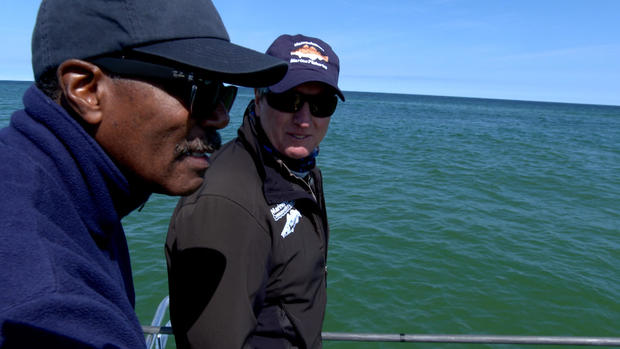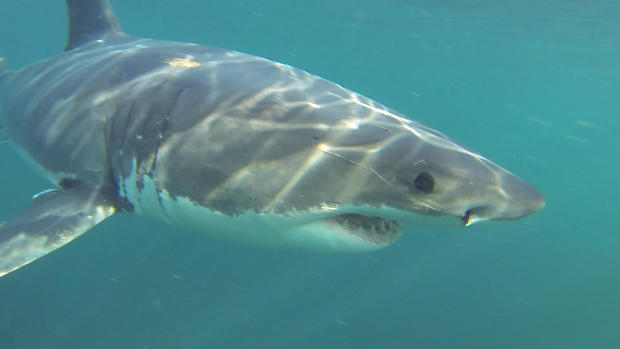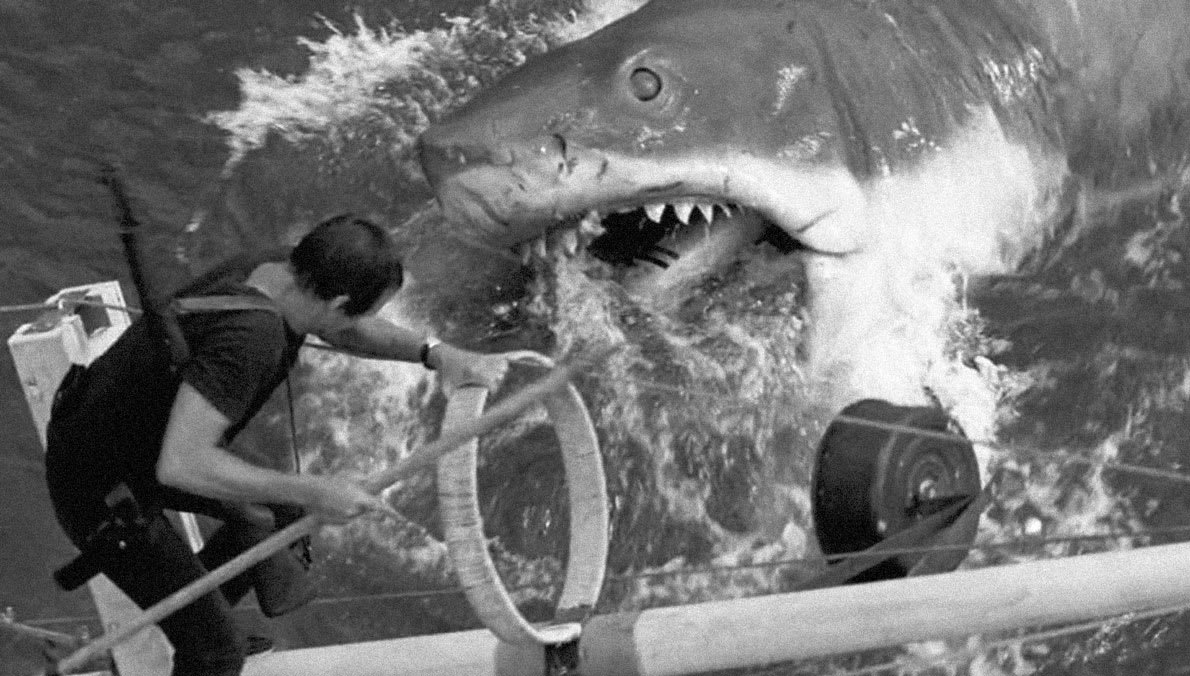The Atlantic great white shark makes a comeback
The book and movie "Jaws" introduced us to the great white shark more than 40 years ago, and scared us out of our wits. Much of the film was shot in the waters off Cape Cod, Massachusetts; the irony is that when it came out in the mid 1970's, there were very few white sharks around Cape Cod.
The species was in the midst of a serious decline, and the movie made it worse. With fishermen hunting the few great whites that there were.
White sharks were granted federal protection in 1997, and in the years since, have made a comeback that has delighted conservationists and frightened swimmers and surfers. On Cape Cod this past summer, shark sightings and beach closings were about as common as lobster rolls. As we first reported last September, the Atlantic great white shark is back.
Greg Skomal: Look at this fish.
Bill Whitaker: Look at this fish.
Greg Skomal: Yeah, look at this fish.
Bill Whitaker: Geez.
On a Tuesday in mid-September, we're with Dr. Greg Skomal, chief shark scientist for the Massachusetts Department of Marine Fisheries, following an 11-foot white shark swimming just feet off the beach near Truro on Cape Cod.
Greg Skomal: And if you're standing there, you don't know that shark's there.
Bill Whitaker: You have no idea!
Greg Skomal: You don't know that shark is there.
Bill Whitaker: No idea. She's like 10 feet off shore!
Greg Skomal: Yeah. Very close now.
White sharks are so close to shore because that's where their favorite food is. Grey seals, thousands of which now call Cape Cod home.
Greg Skomal: This is the restaurant right here. These sharks have found the restaurant, and they're waiting for the doors to open. You know? And when those seals begin to leave the beach… you know?
Bill Whitaker: It's dinnertime.
Greg Skomal: It's dinnertime.
Skomal and his team from the Atlantic White Shark Conservancy are trying to attach electronic tracking tags to as many sharks as they can, nearly 230 so far. The way they do it is fascinating. Pilot Wayne Davis locates sharks from his spotter plane, then guides boat captain John King onto them.
Wayne Davis: Use a little gas, John. He's right on the shoal. It's about as good as it's gonna get.
Standing on a 'pulpit' on the bow of a small boat, Greg Skomal wields a long pole that has a dart and a tag at the end.
Greg Skomal: Right, Right there. Done.
Bill Whitaker: You got him?
Greg Skomal: Tagged.
Bill Whitaker: That was it!
Megan Winton: Beautiful, alright
Captain John King: My God. Beautiful, beautiful placement, Greg.
Greg Skomal: Thank you, John. Nice work.
Bill Whitaker: You can see, you can see where it was?
Greg Skomal: Yeah, you can see it right at the base of the dorsal. See it?
Bill Whitaker: Yeah, yeah, yeah, yeah.
Greg Skomal: Now we're gonna learn about that fish for the next nine, 10 years.
They will track the fish because the tag constantly emits a "ping" that is picked up when the shark swims close to acoustic receivers attached to buoys.
Bill Whitaker: And how many of these do you have up and down the coast?
Greg Skomal: We have over a hundred out all over Massachusetts.
Bill Whitaker: And that's just you. Other people have others.
Greg Skomal: That's just us. Yeah. And so we can actually track the movements of our white sharks when they leave here.
The tags also help Skomal and his research colleague Megan Winton figure out just how many sharks there are, and have established that Cape Cod is now one of the world's white shark "hot spots." They regularly haul buoys out of the water and download data from them to a tablet that displays each time a tagged shark swims by.
Megan Winton: Lots of white shark detections.
This tells them a lot about individuals; they have confirmed that they're loners, and that the same one will often come back to precisely the same hunting ground year after year. A white shark seemed to be hunting Greg Skomal in 2018 when it came up, jaws open, right under the pulpit.
Captain John King: OH! Holy crap!
Greg Skomal: It came right up and opened its mouth right at my feet!
That shook him up for a bit. But he insists it shouldn't shake up the public.
Greg Skomal: All I can tell them is, is that the probability of them being bitten is incredibly low. But there's not much more I can say.
Bill Whitaker: Because that fear is primal.
Greg Skomal: I think that fear is primal. I think it's innate. I think it's in them, it's in us, it's in all of us.
Five days after our day on the water off Cape Cod, we needed a bigger boat, for a very different shark-tagging expedition 600 miles to the northeast, just off hay island in Nova Scotia.
We boarded a 125-foot research ship called Ocearch, which has been tagging Atlantic white sharks from Florida to Canada since 2012. Founder Chris Fischer invited us to join the first day of his 2019 Nova Scotia expedition.
Chris Fischer: And we come up here. We've been here 24 hours. We've seen two or three sharks and no one ever even knew to come look here before.
Ocearch launches a team on a small boat to hook white sharks much as fishermen would, using long lines, bait and floats to keep them near the surface.
Ocearch is a converted Alaskan crab boat equipped with a platform that's lowered into the water off one side. As the small boat tows the shark alongside, Ocearch fishing master Brett McBride leaps onto the submerged platform, into water that's 49 degrees. With the line in his hand, he guides an 1,100-pound male white shark onto the cradle.
Bill Whitaker: Whoa, whoa, look at that.
The platform is raised out of the water, effectively "beaching" the shark. It offers no resistance, worn out after being hooked and "towed" for nearly an hour. McBride gets right in its face to insert a hose between its giant jaws.
Brett McBride: I'm keeping clean seawater flowing over its gills. I'm makin sure it's getting good oxygen.
A team member starts a clock, they don't want to keep the shark out of the water for more than 15 minutes. And Ocearch chief scientist Dr. Robert Heuter gives me an opportunity i'm not quite sure I want.
Dr. Bob Hueter: So Bill, just go ahead, go ahead and take your time, just feel how beautiful that is. (NOISE)
Bill Whitaker: Oh my god.
Dr. Bob Hueter: How smooth. And then go this way. Rub your hand the other way and you feel it's kinda bumpy.
Bill Whitaker: My god.
The Ocearch team swarms the shark, drawing blood and tissue samples, picking off parasites to be analyzed, and measuring its girth and length.
Christian Purcell: 371 total!
That's 371 centimeters, or 12 feet, 2 inches. The biggest Atlantic great white they've caught was a 16-foot female who weighed 3,500 pounds.
As Chris Fischer measures this one, Bob Hueter inserts an acoustic tag like the one Greg Skomal attaches with a dart.
Bill Whitaker: That doesn't harm the shark?
Dr. Bob Hueter: No. It's just, it floats in the body cavity.
Chris Fischer: Let's roll the shark. Everybody step back.
After the shark is rolled onto its belly, Chris Fischer drills through the dorsal fin. He insists it's no more painful than piercing an ear. He's attaching the tag that really sets Ocearch apart in the world of white shark tracking.
Chris Fischer: This spot tag allows us to track this animal in real-time for up to five years.
The spot tag will send a signal to a satellite each time this shark's dorsal fin comes above the surface of the water. Ocearch has put more than 50 of them on Atlantic white sharks, and displays their tracks on its website.
Chris Fischer: And that's how you learn not only where they are, but what they're doing where they are, which is what you need to know to manage. Right? Where's the mating? Where's the birthing? Where's the foraging? Where's the gestating?
While some scientists criticize the Ocearch techniques as too invasive, they are gathering a lot of data; 17 different research projects will get samples and information from a single shark.
Still, there are a lot of unknowns: no white shark has ever been kept in captivity, and no one has ever seen them mate or give birth anywhere. But there are also discoveries: the Ocearch team has confirmed that the waters off Long Island are an important "nursery" for baby whites like these – called "pups."
And back on Cape Cod, acoustic tags are teaching Greg Skomal about just how far adult sharks travel.
Bill Whitaker: What's the most interesting thing you've learned about them?
Greg Skomal: We now know based on the tagging work we've done the last 10 years is that, when they leave Cape Cod, they go down to Florida, and they spend the time in the Gulf of Mexico. And they overwinter in these Southern climates. But since some of these sharks move out into the open Atlantic Ocean, and when they're out in the middle of the Atlantic, they dive down at depths as great as 3,000 feet every day. And there's not a scientist on Earth that can tell you why they do that.
Scientists have learned how long-lived they are.
Greg Skomal: White sharks we now know live over 70 years.
Bill Whitaker: Seventy years?
Greg Skomal: Seventy years.
They don't start hunting seals until their late teens, but when they do, watch out. In this footage Greg Skomal shot, you see a seal leap out of the water with a shark right on its tail.
Here, the shark catches a seal, and the ocean water explodes in blood red in an instant. The shark then swims away with half a seal in its jaws.
Seals have been protected by federal law since 1972, and some 25,000 now live near Cape Cod. More seals means more sharks and that's what worries the swimmers and surfers sharing the water with them.
Great white sharks very rarely attack people. The one that killed a swimmer named Arthur Medici just off this beach last September was the first fatal attack on Cape Cod since 1936. But it triggered a fear of attacks that can hardly be measured.
Scary warning signs on every beach, "stop-bleed kits" at lifeguard stands. A phone app called Sharktivity that reports sightings in real-time, with local news doing much the same, and community meetings packed with frightened citizens.
Bill Whitaker: You're the scientist. But you also live here. And, you know, people are afraid.
Greg Skomal: We can't bury our heads in the sand when it comes to shark attacks. And so that's in my face every day now. And then it always falls back on the-- you know, the question of, "Well, what do you tell your kids to do?" You know?
Bill Whitaker: What do you tell your kids to do?
Greg Skomal: You know, I-- I tell my kids-- don't go out past waist-deep.
That's chilling advice – for swimmers, for surfers, and for the Cape Cod Chamber of Commerce.
Chris Fischer: I mean, we've basically gotta undo everything "Jaws" did. I mean, we've got half the people on the Eastern Seaboard terrified about something that almost never happens.
Bill Whitaker: I saw the teeth on this character here. People who are swimming nearby should not be afraid of that?
Chris Fischer: No. They're clever. Like, even though we dress up like their food and try to fool 'em, they very rarely get fooled.
Bill Whitaker: What do you mean tr-- what do you mean-- dress up like their food?
Chris Fischer: You ever seen what someone in a wetsuit looks like compared to a seal?
He's got a point. When this white shark's 15 minutes on the Ocearch platform ran out, we were ordered off. They gave him a name, Sydney, for the nearest Nova Scotia town, and began lowering him back into the water.
Bill Whitaker: And what you guys have done to him-- this does not harm or hurt the shark at all?
Dr. Bob Hueter: No, because we're-- we're monitoring the stress of the animal throughout.
After a couple of minutes, he perked up, especially when he noticed the Ocearch photographer in the water around the corner.
Finally, with fish-master Brett McBride helping "steer" him by the tail, off went Sydney.
Sydney has been busy in the months since we met him in Nova Scotia. He migrated as far south as Florida, and as of early January his spot tag showed him off the North Carolina coast.
Produced by Rome Hartman. Associate producer, Sara Kuzmarov










